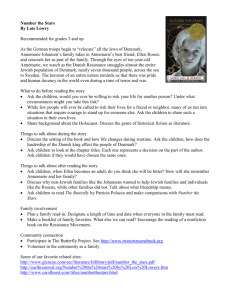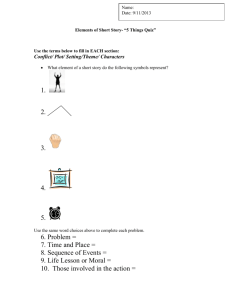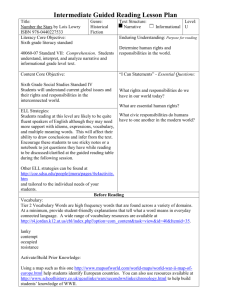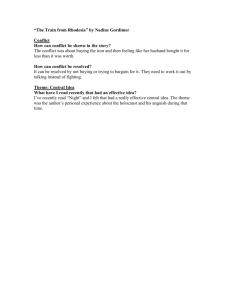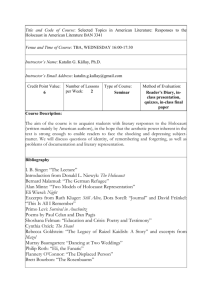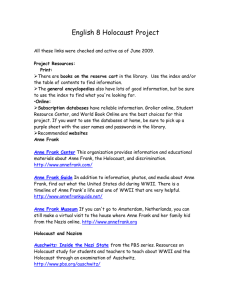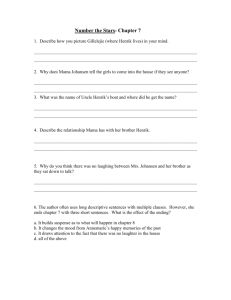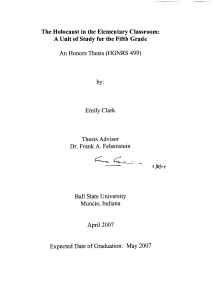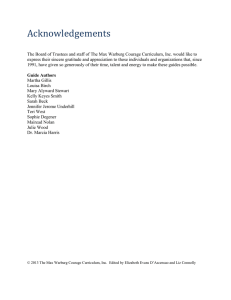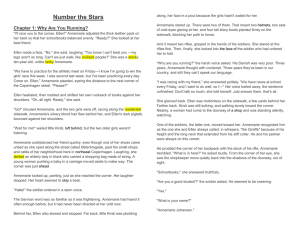Curriculum Map for Thematically-Linked Multi
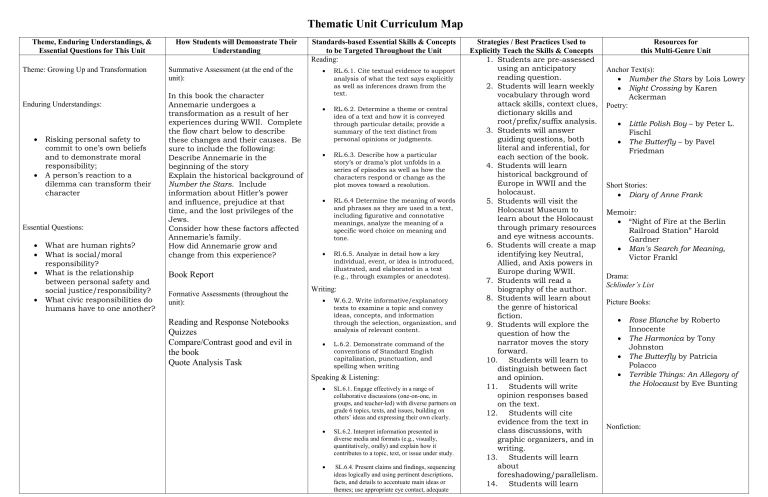
Theme, Enduring Understandings, &
Essential Questions for This Unit
Theme: Growing Up and Transformation
Enduring Understandings:
Risking personal safety to commit to one’s own beliefs and to demonstrate moral responsibility;
A person’s reaction to a dilemma can transform their character
Essential Questions:
What are human rights?
What is social/moral responsibility?
What is the relationship between personal safety and social justice/responsibility?
What civic responsibilities do humans have to one another?
How Students will Demonstrate Their
Understanding
Summative Assessment (at the end of the unit):
In this book the character
Annemarie undergoes a transformation as a result of her experiences during WWII. Complete the flow chart below to describe these changes and their causes. Be sure to include the following:
Describe Annemarie in the beginning of the story
Explain the historical background of
Number the Stars. Include information about Hitler’s power and influence, prejudice at that time, and the lost privileges of the
Jews.
Consider how these factors affected
Annemarie’s family.
How did Annemarie grow and change from this experience?
Book Report
Formative Assessments (throughout the unit):
Reading and Response Notebooks
Quizzes
Compare/Contrast good and evil in the book
Quote Analysis Task
Thematic Unit Curriculum Map
Standards-based Essential Skills & Concepts to be Targeted Throughout the Unit
Reading:
RL.6.1. Cite textual evidence to support analysis of what the text says explicitly as well as inferences drawn from the text.
RL.6.2. Determine a theme or central idea of a text and how it is conveyed through particular details; provide a summary of the text distinct from personal opinions or judgments.
RL.6.3. Describe how a particular story’s or drama’s plot unfolds in a series of episodes as well as how the characters respond or change as the plot moves toward a resolution.
RL.6.4 Determine the meaning of words and phrases as they are used in a text, including figurative and connotative meanings, analyze the meaning of a specific word choice on meaning and tone.
RI.6.5. Analyze in detail how a key individual, event, or idea is introduced, illustrated, and elaborated in a text
(e.g., through examples or anecdotes).
Writing:
W.6.2. Write informative/explanatory texts to examine a topic and convey ideas, concepts, and information through the selection, organization, and analysis of relevant content.
L.6.2. Demonstrate command of the conventions of Standard English capitalization, punctuation, and spelling when writing
Speaking & Listening:
SL.6.1. Engage effectively in a range of collaborative discussions (one-on-one, in groups, and teacher-led) with diverse partners on grade 6 topics, texts, and issues, building on others’ ideas and expressing their own clearly.
SL.6.2. Interpret information presented in diverse media and formats (e.g., visually, quantitatively, orally) and explain how it contributes to a topic, text, or issue under study.
SL.6.4. Present claims and findings, sequencing ideas logically and using pertinent descriptions, facts, and details to accentuate main ideas or themes; use appropriate eye contact, adequate
Strategies / Best Practices Used to
Explicitly Teach the Skills & Concepts
1.
Students are pre-assessed using an anticipatory reading question.
2.
Students will learn weekly vocabulary through word attack skills, context clues, dictionary skills and root/prefix/suffix analysis.
3.
Students will answer guiding questions, both literal and inferential, for each section of the book.
4.
Students will learn historical background of
Europe in WWII and the holocaust.
5.
Students will visit the
Holocaust Museum to learn about the Holocaust through primary resources and eye witness accounts.
6.
Students will create a map identifying key Neutral,
Allied, and Axis powers in
Europe during WWII.
7.
Students will read a biography of the author.
8.
Students will learn about the genre of historical fiction.
9.
Students will explore the question of how the narrator moves the story forward.
10.
Students will learn to distinguish between fact and opinion.
11.
Students will write opinion responses based on the text.
12.
Students will cite evidence from the text in class discussions, with graphic organizers, and in writing.
13.
Students will learn about foreshadowing/parallelism.
14.
Students will learn
Resources for this Multi-Genre Unit
Anchor Text(s):
Number the Stars by Lois Lowry
Night Crossing by Karen
Ackerman
Poetry:
Little Polish Boy – by Peter L.
Fischl
The Butterfly – by Pavel
Friedman
Short Stories:
Diary of Anne Frank
Memoir:
“Night of Fire at the Berlin
Railroad Station” Harold
Gardner
Man’s Search for Meaning,
Victor Frankl
Drama:
Schlinder’s List
Picture Books:
Rose Blanche by Roberto
Innocente
The Harmonica by Tony
Johnston
The Butterfly by Patricia
Polacco
Terrible Things: An Allegory of
the Holocaust by Eve Bunting
Nonfiction:
volume, and clear pronunciation.
L.6.1. Demonstrate command of the conventions of Standard English grammar and usage when writing or speaking. literary terms and complete a plot triangle for the book.
15.
Students will learn how to compare and contrast.
16.
Students will learn characterization through text evidence and inferential thinking
17.
Students will create a
Venn diagram comparing and contrasting two characters in the book.
18.
Students will learn the significance of symbolism in the story, in particular the Star of David, the shell, the title, and the woods.
19.
Students will identify themes in the book, citing text evidence.
20.
Students will analyze important quotes through class discussions. and writing.
21.
Students will identify cause and effect relationships.
22.
Students will learn about the progression of character from the fantasy world of a child to the reality of the world she’s in
23. Students will analyze the main character’s transformation utilizing evidence from the text, supplemental readings, and skills developed through the unit.
